重大版高中英语必修10:The Delights of Books
- 格式:ppt
- 大小:1.52 MB
- 文档页数:58
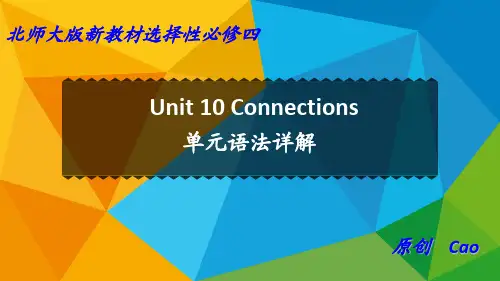

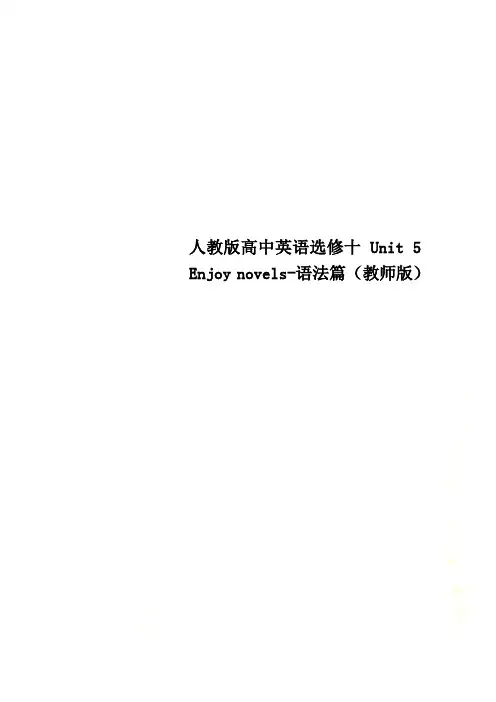
人教版高中英语选修十 Unit 5 Enjoy novels-语法篇(教师版)(2) 独立主格结构可置于句首, 也可以放在句尾;(3) 独立主格结构主要用于书面语;(4) 独立主格结构的逻辑主语与句中的语法主语不同, 不指同一个人或同一事物;(5) 独立主格结构的逻辑主语与句子的主语不同, 它独立存在;(6) 名词或代词与后面的分词, 形容词, 副词, 不定式, 介词等是主谓关系;(7) 独立主格结构一般有逗号与主句分开(8) 过去分词表示被动,逻辑主语承受动作;分词的完成式表示的动作在谓语动词所表示的动作之前发生。
e.g. 1) The test finished, we began our holiday.= When the test was finished, we began our holiday.2) The president assassinated, the whole country was in deep sorrow.3) Weather permitting, we are going to visit you tomorrow.4) He came into the room, his ears red with cold.5) He came out of the library, a large book under his arm.3. with 的复合结构作独立主格表伴随时, 既可用分词的独立结构, 也可用with 的复合结构。
其结构如下:(1) with + 名词/代词宾格+ 介词短语(2) with + 名词/代词宾格+ 分词(3) with + 名词/代词宾格+ 不定式(4) with + 名词/代词宾格+ 形容词/副词(5) with + 名词/代词宾格+ 名词e.g. 1) The teacher entered the classroom, with a book in his hand.2) The classroom is very bright with all the lights turned on.3) I can’t go out, with a lot of work to do.4) Don’t talk with your mouth full.5) He fought the tiger with a stick as his only weapon.4. 独立主格结构的句法功能(1) 作时间状语e.g. The meeting over, they left the hall.(2) 作原因状语e.g. My watch having been lost, I didn’t know what time it was.(3) 作条件状语e.g. Time permitting, I shall go to the cinemawith you.(4) 描述伴随行为或补充说明e.g. Mary entered the room, with a big apple in her hand.He stood there, with his hands in his pockets.1.____________ her father, the little girl ran to him,her schoolbag ________ behind her.A. Seeing; flyingB. Seen; flownC.To see; to fly D. Seeing; was flying解析: 第一空相当于when the little girl saw her father, 其可改为seeing her father;第二空考查独立主格结构做伴随状语。
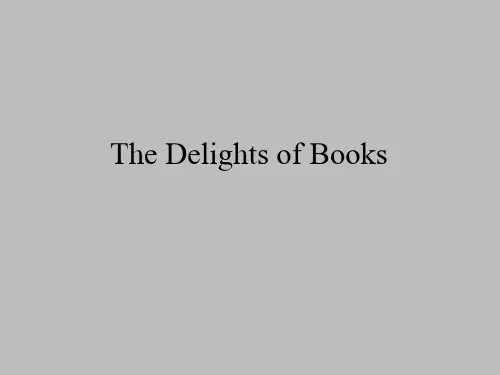

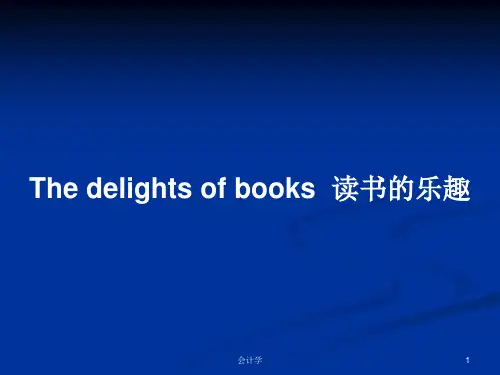
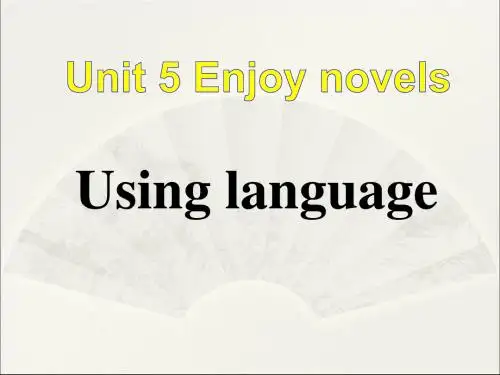
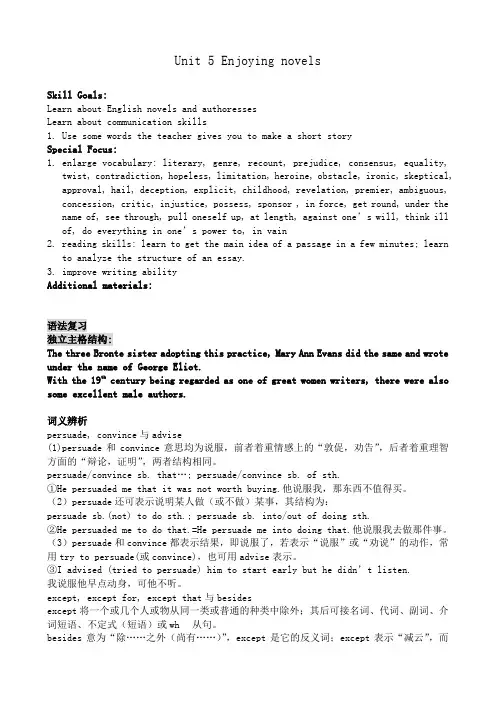
Unit 5 Enjoying novelsSkill Goals:Learn about English novels and authoressesLearn about communication skillse some words the teacher gives you to make a short storySpecial Focus:1.enlarge vocabulary: literary, genre, recount, prejudice, consensus, equality,twist, contradiction, hopeless, limitation, heroine, obstacle, ironic, skeptical, approval, hail, deception, explicit, childhood, revelation, premier, ambiguous, concession, critic, injustice, possess, sponsor , in force, get round, under the name of, see through, pull oneself up, at length, against one’s will, think ill of, do everything in one’s power to, in vain2.reading skills: learn to get the main idea of a passage in a few minutes; learnto analyze the structure of an essay.3.improve writing abilityAdditional materials:语法复习独立主格结构:The three Bronte sister adopting this practice, Mary Ann Evans did the same and wrote under the name of George Eliot.With the 19th century being regarded as one of great women writers, there were also some excellent male authors.词义辨析persuade, convince与advise(1)persuade和convince意思均为说服,前者着重情感上的“敦促,劝告”,后者着重理智方面的“辩论,证明”,两者结构相同。
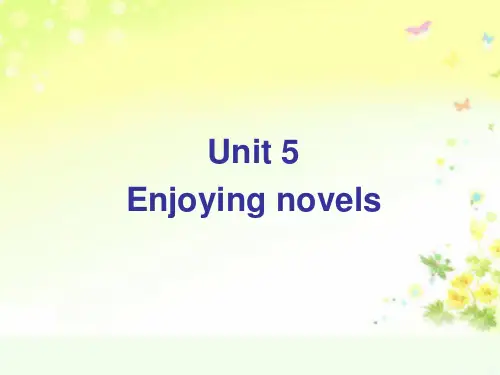
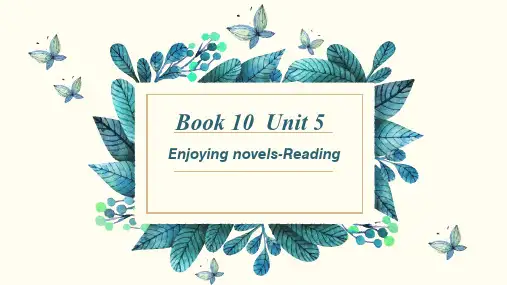
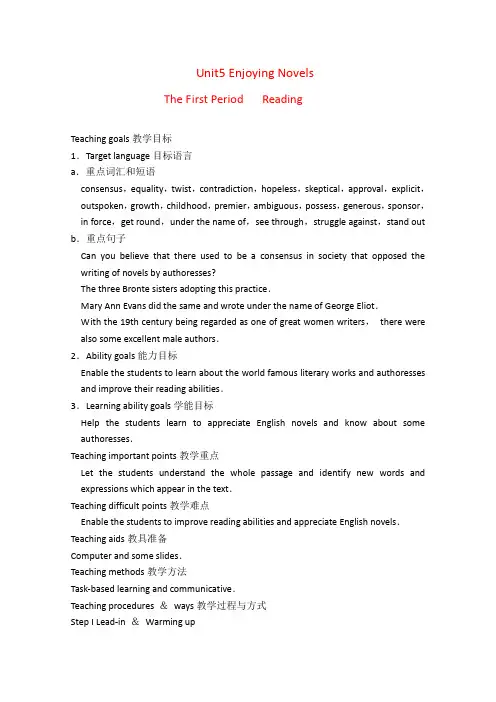
Unit5 Enjoying NovelsThe First Period ReadingTeaching goals教学目标1.Target language目标语言a.重点词汇和短语consensus,equality,twist,contradiction,hopeless,skeptical,approval,explicit,outspoken,growth,childhood,premier,ambiguous,possess,generous,sponsor,in force,get round,under the name of,see through,struggle against,stand out b.重点句子Can you believe that there used to be a consensus in society that opposed the writing of novels by authoresses?The three Bronte sisters adopting this practice.Mary Ann Evans did the same and wrote under the name of George Eliot.With the 19th century being regarded as one of great women writers,there were also some excellent male authors.2.Ability goals能力目标Enable the students to learn about the world famous literary works and authoresses and improve their reading abilities.3.Learning ability goals学能目标Help the students learn to appreciate English novels and know about some authoresses.Teaching important points教学重点Let the students understand the whole passage and identify new words and expressions which appear in the text.Teaching difficult points教学难点Enable the students to improve reading abilities and appreciate English novels.Teaching aids教具准备Computer and some slides.Teaching methods教学方法Task-based learning and communicative.Teaching procedures &ways教学过程与方式Step I Lead-in &Warming upT:Good morning,students.I heard that most of our students like to play the computer games,such as“大话西游”and“三国志”.We are all familiar with these stories.Do you know where t11ese stories are from?S1: They are all from ancient,Chinese stories.S2:“大话西游”comes from the novel “Journey to the West".S3:“三国志”comes from the novel “Romance of Three Kingdoms.T:These novels are very popular in China.The two novels are called “the Four Ch inese Classical Novels” by Chinese.The others are “Dream of Red Mansions”《红楼梦》and “Water Margin”《水浒传》.Have you read them?Ss: Yes.T: They are the representations of Chinese novels. Have you read any foreign novels? Ss: Yes.T: OK. Today we will have a new period about literature. Let's have a discussion about literature according to these questions.Show the four questions on the slides.T: I'll give you five minutes to discuss and then ask some students to answer the questions.S1: I like novels because we can learn the background of that society after reading novels. I am very relaxed when I read a novel.T: Good. The next one.S2: I like classical literature. Reading classical literature written by native speakers can improve my English language skills in several ways and we could get knowledge about history. I've read "Jane Eyre" and I like the heroines very much.T: Well done. The third one.S3: I like English novels better. I've read "Wuthering Heights".T: Good. The last question. It's a little difficult.S4: Yes. Once there was a little boy who had a bad temper. His father gave him a bag of nails and told him that when he lost his temper, he must hammer a nail into the fence. The first day the boy hammered 37 nails into the fence. Over the next few weeks, as he learned to control his anger, the number of nails hammered daily gradually dwindled down. He discovered it was easier to hold his temper than to drive those nails into the fence...Finally the day came when the boy didn't lose his temper at all. He told his father about it and the father suggested that the boy pull out one nail for each day when he was able to hold his temper. The daypassed and one day the young boy told his father that all the nails were gone. The fence would never be the same. When you say things in anger, they leave a scar just like those nails.T: You have done a good job. I am very glad you've read some English novels.Step Ⅱ Pre-readingT: Please look at the slides. Can you match the titles of these famous novels to the authors? Maybe some authors whom you are not very familiar with. Have a try. Show the slide.Three minutes later, check the answers.T: There are nine authors. Do you know how many female authors are there?S1: There are six female authors. They are Jane Austen, Charlotte Bronte, Emily Bronte, Harper Lee, Anne Bronte and Margaret Mitchell.T: Please look at the picture on the right. She is the famous author who writes the novel "Gone with the Wind".Step ⅢWhile-readingT: How many English authoresses in the 19th century in the text? Who are they? What are their works mentioned in the text? Read the text as quickly as possible, and try to find out the answers to the questions in two minutes, I'll time you. (Design a clock which can work and sound when time is up) Have you got your answers?S6: There are five authoresses in the 19th century in the text. They are Jane Austen, the three Bronte sisters (Charlotte, Emily and Anne), and the writer known as George Eliot. "Pride and Prejudice" written by Jane Austen, "Jane Eyre" written by Charlotte Bronte and "Silas Marner" written by George Eliot are mentioned in the text.T: Well done. Sit. down, please. Do you understand this passage? What does the author tell us in the first paragraph?S7: Consensus in society opposed the writing of novels by authoresses. But this period produced five of the most courageous and gifted authoresses. They are Jane Austen, the three Bronte sisters (Charlotte, Emily and Anne), and the writer known as George Eliot.T: Good. Who can tell us the general idea of paragraphs 2 to 3?S8: The general idea of paragraphs 2 to 3 is the introduction of Jane Austen and her work "Pride and Prejudice".T: It is not very specific. Let's learn more about Jane Austen and "Pride and Prejudice".Jane Austen was born in a country clergyman's family on 16 December, 1775, in the parish of Steventon. She was brought up in an intelligent but restricted environment. Her father was a priest and scholar with a good library. She was.educated at home with her sister. Through a wide reading of books available in her father's library, Jane acquired a thorough knowledge of eighteen century English literature, including the moral philosophy of Dr Johnson, the, poetry, of W. Cowper, as well as the novels by Richardson and Fielding. She lived in a quiet, retired and, in public terms, uneventful life, though she did move to several places like Bath, Southampton and Chawton. And her closest companion was her elder sister Cassandra, who, never married. Austen began as a child to write novels for her family entertainment. Her works were later published anonymously due to the prejudice against women writers then. In her lifelong career, Jane Austen wrote altogether six complete novels. She died in Winchester. Jane Austen is particularly preoccupied with the relationship between men and women in love. Stories of love and marriage provide the major themes in all her novels, in which female characters are always playing an active part. In their pursuit of a marriage, they are usually categorized into three types according to their different attitudes: those who would marry for material wealth and social position, those who would marry just for beauty and passion, and those who would marry for true love witha consideration of the partner's personal merit as well as his economical andsocial status. In another word, Jane Austen tries to say that it is wrong to marry just for money or for beauty, but it is also wrong to marry without it.Do you understand the paragraphs 2 to 3 ?Ss: Yes.T: The fourth paragraph means that after Jane Austen, authoresses found it an even more hopeless task to publish novels under their own names. So they chose to publish their works using men's names. How much do you know Charlotte Bronte and her work "Jane Eyre"?S9: Charlotte Bronte was the most famous of the three Bronte sisters. Her most famous book, Jane Eyre, describes the growth of a poor, abused heroine with an unhappy childhood who finds eventual happiness after many struggles and disappointments. Being immediately hailed as "the master work of a great genius", Jane Eyre became a great success.T: Do you want to know more about Charlotte Bronte and her work "Jane Eyre"?Ss: Yes.T: Charlotte Bronte came from a large family of Irish origin. Their father was a clergyman at Haworth, Yorkshire. When they were young, the Bronte sisters were sent to a school for clergymen's daughters. The eldest two died there due to the poor and unhealthy conditions. This experience inspired the later portrayal of Lowood School in the novel "Jane Eyre". As they grew up, the sisters worked either as teacher or governess in some private families. In 1842, in order to open up a school of their own, Charlotte and Emily went to Brussels to improve their foreign language. The two years there left hardly any trace on Emily but for Charlotte the change was most fundamental. There she fell in love with her German professor, a married man. This passionate yet one-side love was later recounted in her works, especially in Villette. Charlotte's works are all about the struggle of an individual consciousness towards self-realization, about some lonely and neglected young women with a fierce longing for love, understanding and a full, happy life.T: Look at the sixth paragraph, boys and girls. This paragraph has to do with George Eliot and her work "Silas Marner". I would like to tell you more about George Eliot and her work "Silas Marner". George Eliot, pseudonym of Mary Ann Evans, was born on Nov. 22, 1819 into an estate agent's family in Warwickshire, England. As a small child, she showed no evidence of special talent except a passionate longing to be loved. By the time of her teenage, however, her extraordinary intelligence began to be acknowledged both at home and at school. Brought up with the strict orthodox teaching and influenced by her first school-teacher Miss Lewis, the bookish girl devoted herself, for four years, to a diligent study of the Scripture. Unfortunately, she was forced to drop school at the age of 16 on account of her mother's death and sister's marriage, and yet, meanwhile, she continued her study at home and managed to learn three foreign languages and music all by herself. In her works, she seeks to present the inner struggle of a soul and to reveal the motives, impulses and hereditary influences, which govern human action. So much for George Eliot. Have you read "David Copperfield"?S10: Yes, I have.T: Say something about this book.S10: In "David Copperfield", the hero experiences suffering before he meets his eccentric, kind and tolerant aunt, Betsy Trotwood. David benefits from her trulygenerous nature, and owes his education, wealth and happiness to her care.T: After explanation of the text, who can tell me the main idea of the passage?S1: The main idea of the passage is to tell us the social background of that society.T: Well done. Who has different opinion?S2: The main idea of the text is to tell us men and women have equal rights. What's more, women are independent, not men's accessories. Women can do anything men can. Maybe women can do everything better than men. It is wrong to discriminate against women.T: Fantastic! Your pronunciation and intonation make you sound like a native speaker. I agree with your answer. If the others have different ideas, keep it and we'll discuss it after class,T: Well. We've talked enough about the text. let's have a relax. I'll tell you a joke for a break. "So you think you've got problems! " a man said to his co-worker. "I lent a guy $4,000 for plastic surgery, and now I don't know what he looks like!Ss: Ha-ha.T: From your laughter, I see you've understood the joke.Step IV Language focusWords and useful expressions:1.in force1) “in force” in the text means “being used”.e.g.The new regulations are now in force.新规章已生效。
《The Delights of Books》教学设计一、教学目标1、知识与技能目标学生能够理解并运用与书籍相关的词汇和表达方式,如“fiction”“nonfiction”“enlightening”“entertaining”等;能够用英语描述书籍带来的乐趣和益处;能够阅读并理解关于书籍的简单英文文章。
2、过程与方法目标通过阅读、讨论、写作等活动,培养学生的英语语言运用能力和思维能力;引导学生学会从书籍中获取信息、思考问题和表达观点。
3、情感态度与价值观目标激发学生对阅读的热爱,培养学生的阅读习惯和文化素养;让学生体会到书籍在丰富人生、拓展视野和增长知识方面的重要作用。
二、教学重难点1、教学重点掌握与书籍相关的词汇和句型;理解文章中关于书籍乐趣的描述;能够用英语表达自己对书籍的喜爱和从书籍中获得的收获。
2、教学难点如何引导学生深入思考书籍带来的精神享受和个人成长;如何帮助学生克服用英语表达复杂情感和观点时的语言障碍。
三、教学方法1、任务驱动教学法布置与书籍相关的任务,如阅读短文、写读后感等,让学生在完成任务的过程中提高语言能力。
2、情景教学法创设与阅读和书籍相关的情景,如图书馆、书店等,让学生在真实的情境中感受书籍的魅力。
3、小组合作学习法组织学生进行小组讨论和合作活动,鼓励学生分享自己的阅读体验和观点,培养学生的合作精神和交流能力。
四、教学过程1、导入(5 分钟)通过展示一些著名书籍的封面图片或播放一段关于书籍的简短视频,引起学生的兴趣。
提问学生:“What do you think of books?”引导学生用简单的英语表达对书籍的初步印象。
2、词汇学习(10 分钟)呈现与书籍相关的词汇,如“novel”“biography”“history”“science”“fantasy”等,讲解词汇的含义和用法。
通过单词游戏或造句练习,帮助学生巩固所学词汇。
3、阅读文章(15 分钟)分发一篇关于书籍乐趣的英文短文,让学生阅读。
《The Delights of Books》教学设计一、教学目标1、让学生理解书籍所带来的愉悦和价值。
2、培养学生阅读和欣赏不同类型书籍的能力。
3、激发学生对阅读的热爱,养成良好的阅读习惯。
二、教学重难点1、重点引导学生体验书籍带来的各种愉悦感受。
帮助学生掌握不同类型书籍的特点和阅读方法。
2、难点如何让学生深刻理解书籍对个人成长和心灵滋养的重要性。
怎样激发学生持续的阅读兴趣,使其将阅读作为一种长期的爱好。
三、教学方法1、讲授法讲解书籍的历史、种类和价值。
分享著名作家和读者对书籍的赞美之词。
2、讨论法组织学生讨论自己喜欢的书籍以及从中获得的乐趣。
探讨如何在繁忙的生活中保持阅读习惯。
3、阅读分享法安排学生进行简短的阅读分享,介绍一本自己喜爱的书。
4、多媒体辅助教学展示与书籍相关的图片、视频等资料,增强学生的直观感受。
四、教学过程1、导入(5 分钟)展示一些精美的书籍封面图片,引发学生的兴趣。
提问学生是否喜欢读书,以及最近读过的一本好书。
2、知识讲解(15 分钟)介绍书籍的发展历程,从古代的竹简、羊皮卷到现代的电子书。
讲解不同类型的书籍,如小说、传记、科普读物、诗歌等的特点和阅读方法。
3、小组讨论(15 分钟)将学生分成小组,讨论以下问题:你在阅读中体验到的最大乐趣是什么?什么样的书最能吸引你?每个小组推选一名代表,进行全班交流。
4、阅读分享(15 分钟)请几位学生上台分享自己最喜欢的一本书,包括书籍的内容、自己的感悟以及喜欢的原因。
5、深入探讨(10 分钟)引导学生思考书籍对个人成长的重要性,例如拓宽视野、增长知识、培养思维能力等。
讨论在现代科技发达的情况下,如何平衡电子阅读和纸质阅读。
6、总结与作业布置(5 分钟)总结本节课的重点内容,强调书籍带来的愉悦和价值。
布置作业:让学生写一篇短文,描述自己理想中的书房。
五、教学资源1、多媒体设备,用于展示图片、视频等资料。
2、相关书籍样本,供学生传阅和观察。
《The Delights of Books》教学设计一、教学目标1、知识与技能目标学生能够理解并掌握文章中的重点词汇、短语和句型。
学生能够准确理解文章的主旨大意,把握作者的观点和情感。
2、过程与方法目标通过阅读、讨论和写作等活动,培养学生的阅读理解、分析和表达能力。
引导学生运用阅读策略,如预测、推理、总结等,提高阅读效率。
3、情感态度与价值观目标激发学生对阅读的兴趣,培养学生热爱书籍、享受阅读的良好习惯。
让学生体会书籍带来的乐趣和价值,鼓励学生在日常生活中积极阅读。
二、教学重难点1、教学重点理解文章中的长难句和重点词汇的用法。
掌握文章的结构和写作手法,分析作者如何阐述书籍的乐趣。
2、教学难点引导学生深入思考书籍的意义和价值,培养批判性思维。
让学生能够用自己的语言表达对书籍乐趣的理解和感受。
三、教学方法1、任务驱动教学法布置阅读任务,让学生在规定时间内完成阅读,培养学生的阅读速度和理解能力。
2、小组合作学习法组织学生进行小组讨论,交流对文章的理解和感受,培养学生的合作能力和表达能力。
3、情景教学法创设与阅读内容相关的情景,帮助学生更好地理解文章的背景和主题。
四、教学过程1、导入(5 分钟)展示一些精美的书籍封面图片,提问学生是否喜欢阅读以及喜欢阅读的原因。
引导学生思考书籍在生活中的重要性,从而引出本节课的主题《The Delights of Books》。
2、阅读前(5 分钟)介绍文章的作者和写作背景,帮助学生更好地理解文章的创作意图。
预习文章中的生词和短语,如“delight”“immerse”“enrich”等,为阅读扫清障碍。
3、阅读中(20 分钟)快速阅读:让学生快速浏览文章,概括文章的主要内容,训练学生的阅读速度和概括能力。
仔细阅读:引导学生逐段阅读,分析文章的结构和段落大意,理解作者的观点和论证方法。
重点词句讲解:对文章中的长难句和重点词汇进行讲解和分析,帮助学生准确理解文章的含义。